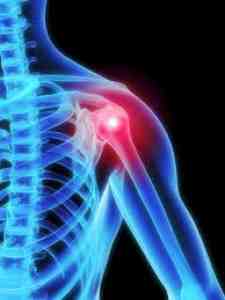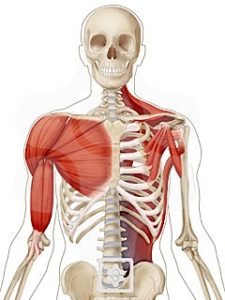 The shoulder is a complex area in terms of the structure of the bones, joints, musculature and attachments. It is more involved than the other areas we have written about, such as the lower back, hand and wrist. In addition, the shoulder is one of the most mobile joints in the body. And there’s a trade off: the more mobile a joint is, the less stability it has.
The shoulder is a complex area in terms of the structure of the bones, joints, musculature and attachments. It is more involved than the other areas we have written about, such as the lower back, hand and wrist. In addition, the shoulder is one of the most mobile joints in the body. And there’s a trade off: the more mobile a joint is, the less stability it has.
Yet despite this dynamic, we can verify simple steps that give us quality results if the shoulder becomes problematic. It’s like turning on a light switch. You don’t have to understand electricity in order to turn on the light. With the shoulder, it’s not as important to understand the specifics of the problem as much as knowing how to take care of it. The way to take care of it, short and long term, is a 3 step process. What’s wrong can be 100 things. And in many instances, a precise diagnosis is not necessary for healing to occur. At Dorfman Kinesiology we’re fortunate that we can take a complicated situation and simplify a solution that’s somewhat universal. Below is a crash course in the 3 movements of the shoulder that make all the difference in the long-term health and well-being of the joint.
1. The shoulders can move up and down. Feel the difference between lifting your shoulders toward the ears, and bringing them down away from the ears. This is a shrugging movement. We want to keep the shoulders down.
2. The shoulders can move forward or back. When you hunch over your computer, your shoulders are in the forward position. Moving your shoulders back will lift and open the chest . We want the shoulders back.
3. The shoulders rotate. This external rotation is the extra dimension and is the hardest to find. The ideal placement of the shoulders brings the lower tips of the scapula bones together. To simplify this movement I suggest keeping the elbows in as close to the the torso/ribs as possible, or when the arms are extended, elbows should move toward each other.
Check out this video for a simple demonstration of these 3 points.
When all 3 of these pieces are correct, you’re good to go. For the most part. With the shoulder, when the alignment is correct, muscle tension can release. In other words, if the bones are positioned properly, the muscles can relax, alleviating pain and immobility.
In my opinion, shoulder problems are often misunderstood, misdiagnosed and mistreated. An individual goes to their doctor and says, “Oh my shoulder is hurting”, but that’s not enough information to understand the problem, or the solution. The symptoms need to be clear and specified as to exactly where it hurts, and when. Point to where it hurts. Tell me what movements cause pain or discomfort. Location matters.
There are many moving and hard to access parts of the shoulder, and multiple points of potential breakdown. There are the cases that are painful in the muscle with rotator cuff involvement and nerve impingement. The deltoid muscles can get overly tight and painful. There can be biceps innervation, which is devastating on the shoulder as well as pain on the backside of the arm, in the triceps area. In addition, there’s possible swelling in the bursa sac area (bursitis), where the muscles attach to the bone. Plus, you can have an arthritic condition in the joint. For an inside view of the anatomy of the shoulder, click here for a great, 2 minute animated video by Virtual Medical Center.
are painful in the muscle with rotator cuff involvement and nerve impingement. The deltoid muscles can get overly tight and painful. There can be biceps innervation, which is devastating on the shoulder as well as pain on the backside of the arm, in the triceps area. In addition, there’s possible swelling in the bursa sac area (bursitis), where the muscles attach to the bone. Plus, you can have an arthritic condition in the joint. For an inside view of the anatomy of the shoulder, click here for a great, 2 minute animated video by Virtual Medical Center.
It is important, however, to differentiate between a shoulder injury and a hurt shoulder. The difference is that one needs surgery and the other needs treatment. And it’s often impossible to know which is which without some primary intervention. Even with the help of x-rays and MRIs. With an x-ray, for example, we often see bone spurs in the shoulders, which is a common problem. Some bone spur cases resolve through my methods and some don’t. My general rule in working with shoulders is, if the problem doesn’t resolve in a timely manner at Brian Dorfman Kinesiology, I will help patients find good surgical options. Still, 90% of shoulder cases resolve in less then 3 months under our care.
If you are one of the nearly 10 million people in this country who experiences shoulder pain, make an appointment with BDK today. There’s a good chance we can help resolve the problem without medication or surgery. Or, if your doctor has recommended surgery, call us for a second opinion. And remember to keep your shoulders down and back with your elbows in. Feel better forever with correct shoulder alignment today.

Thank you Brian.
I am reminded of good positions and will see what happens here.
I think I was too enthusiastic about a yoga stretch Marichyasana…
and might have pulled something. Also being 57 and suddenly lifting a lot of heavy paper and moving around a lot around printing equipment with pulling and pushing of trays, etc.
Am reminded of elbows in and shoulders down always…
Thanks for your comments. Always important to keep that good positioning in mind with any yoga pose to reduce risk of injury and increase benefits.